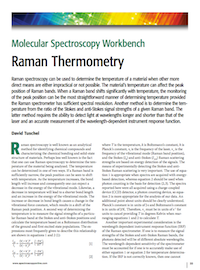- Spectroscopy E-Books-12-01-2016
- Volume e4
- Issue 2
Raman Thermometry
Raman spectroscopy can be used to determine the temperature of a material when other more direct means are either impractical or not possible. The material’s temperature can affect the peak position of Raman bands. When a Raman band shifts significantly with temperature, the monitoring of the peak position can be the most straightforward manner of determining temperature provided the Raman spectrometer has sufficient spectral resolution. Another method is to determine the temperature from the ratio of the Stokes and anti-Stokes signal strengths of a given Raman band. The latter method requires the ability to detect light at wavelengths longer and shorter than that of the laser and an accurate measurement of the wavelength-dependent instrument response function.
Read more
.
Read
.
Articles in this issue
about 9 years ago
Raman Mapping of Spectrally Non-Well-Behaved Speciesabout 9 years ago
Photoluminescence Spectroscopy Using a Raman Spectrometerabout 9 years ago
Selecting an Excitation Wavelength for Raman Spectroscopyabout 9 years ago
Characterizing Modified Celluloses Using Raman SpectroscopyNewsletter
Get essential updates on the latest spectroscopy technologies, regulatory standards, and best practices—subscribe today to Spectroscopy.


